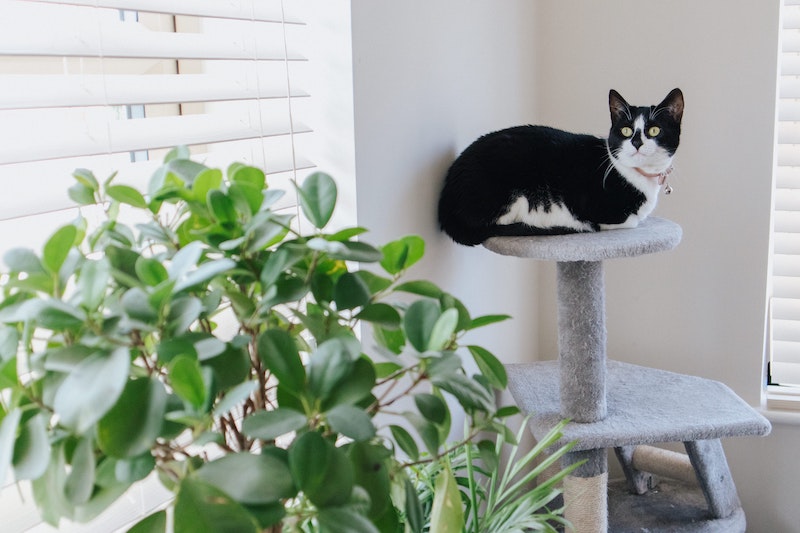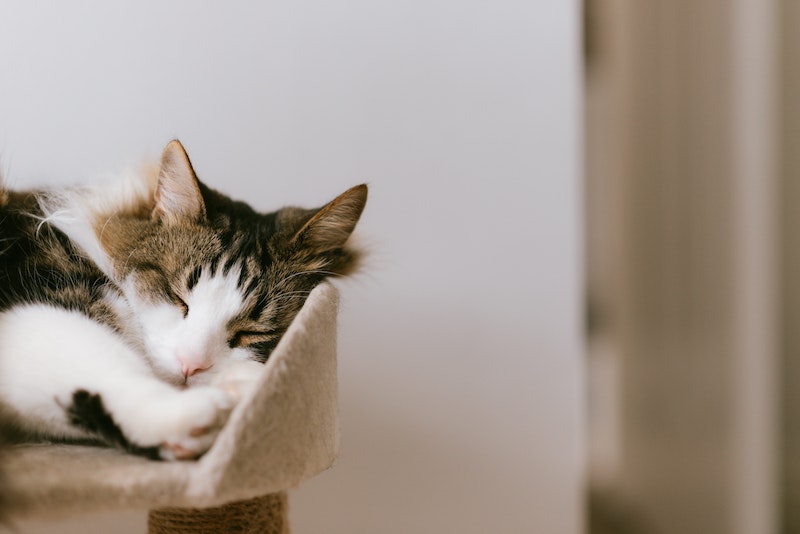- What’s the point of cat furniture?
- Can my pet get hurt on something like a cat tower?
- Okay. So how much does it cost?
- What is modern cat furniture made out of?
- Do they make organic cat furniture, if I’ve got a refined feline?
- Can my dog use that cat condo?
- Is there cat furniture that could work for a small apartment? I live in a tiny studio.
- Before we go...
Your cat eats the finest kibble. She does her business in a mod litter box. She’s showered with love, affection, and endless compliments. So why is she still sleeping on a ratty old pillow, and scratching her claws on the side of your couch?
Cat furniture is one way you can upscale your home for your furry friend. From elaborate cat trees with many perches to cat towers, these pieces of furniture—some fancy, some basic—are made for feline enjoyment.

In general, cat furniture refers to a wide range of items, from scratching posts to multi-level towers with built-in beds and hiding spots. There are so-called deluxe “cat condos,” as well as bespoke cat beds, structures that incorporate cat scratchers, “cat caves,” cat hammocks, window perches, and other variations.
Let’s take a look at some common types for cat lovers, as well as what this furniture will cost you.
What’s the point of cat furniture?
Cats appreciate cat furniture since it presents oodles of opportunities for their favorite habits—like climbing, perching, and scratching, not to mention napping.
Scratching, in particular, is vital for cats because it helps them mark their territory and keep their claws in good condition. Cat furniture also provides an outlet for scratching that doesn’t totally ruin your own furniture or belongings. That means you can finally think about investing in a loveseat that costs more than $50.
Can my pet get hurt on something like a cat tower?
Good question! Like most things, cat furniture isn’t risk-free. One potential issue is that it can be dangerous if it is not sturdy and well-made. If a cat tree or tower collapses while your cat is using it, it could cause injury to your pet.
Invest in a high quality piece, and inspect it regularly to make sure that there’s no wear and tear affecting the structure. Of course, take extra care if you’re the one assembling the furniture yourself, or building a DIY piece from scratch—follow the instructions, and don’t cut any corners. You can also anchor your cat furniture to the wall with furniture anchors typically used for baby proofing.
The main injuries your feline friend might encounter when navigating their furniture would be sprains, strains, or bruises if they take a tumble. In some cases, cats can also get their claws snagged on certain surfaces. You can help prevent this by regularly trimming your cat’s claws at home (though never, ever consider declawing them).
In short: Keep an eye on your cat, especially when they’re first getting used to the furniture. If they’re having issues, or if the furniture itself seems a bit wonky, maybe reconsider the addition to your home.
Okay. So how much does it cost?
As with many things pet-related, the answer might boil down to: How much do you wanna spend? A basic scratching post can cost as little as $20, while a larger, multi-level cat tower can cost several hundred dollars.
In general, it’s a good idea to spend a bit more to get a well-made and durable cat tree that will last for years and provide your cat with opportunities to relax. Amazon and Etsy both have ample options.

Here are some specific pieces available, to give you an idea of the range:
•Mau charges $289 for a two-tiered cat tree with two “napping baskets” and a fuzzy “cave” for chilling out. Other items can top $300. But keep in mind you’re paying for your cat’s comfort as well as a piece of statement furniture that’s meant to look sorta chic, even when your kitty’s nowhere near it.
•Don’t care as much about how your cat furniture looks? Chewy has a plethora of less “design-y”, sub-$100 options from the brand Frisco that should do the job.
What is modern cat furniture made out of?
First of all, plenty of cat furniture is stylish, and there are options if you’re looking for a modern design to complement your existing home decor.
Common materials include wood, carpet, and sisal rope (a type of natural fiber that is often used to make rope and twine). The base of the furniture is often made of solid wood, while the platforms and hiding spots may be covered with carpet or other soft materials.
Scratching posts are often made of sisal rope or a similar material that is tough and durable, allowing cats to scratch without messing up the post. Some cat trees may also include synthetic fabrics or other materials to provide additional comfort and interest for your cat—stuff like faux fur.
But be sure to regularly inspect cat furniture to be sure they are not able to ingest any pieces. This is particularly important with long string materials, shag carpets, ropes, or pieces that could result in GI issues or obstructions.
Do they make organic cat furniture, if I’ve got a refined feline?
Yes, there are companies that make organic cat furniture! This means natural and sustainable materials, such as organic cotton, bamboo, and wool, rather than synthetic fabrics or other materials that could contain chemicals or other arguably harmful substances.
For instance, there are cat trees made from bamboo or other sustainable woods, scratching posts covered with organic cotton or wool, and beds stuffed with organic cotton or wool filling. Needless to say, organic cat furniture will likely be pricier than its non-organic counterparts.
Can my dog use that cat condo?
While cats are the intended consumers, some pups may safely use this furniture as well. Smaller dogs may be able to climb and play on a cat tree or scratching post, while larger dogs may not be able to fit or may be too heavy for the furniture. (Your Great Dane isn’t going to squeeze into that teeny-tiny hammock.)
In any case, it’s a good idea to supervise your dog and monitor their behavior, and to stop them if they seem uncomfortable or if the furniture appears to be unstable. Ultimately, it’s best to provide your dog with their own toys and equipment that are specifically designed for their size and needs.
You know who shouldn’t climb on cat furniture? Humans, especially tiny humans. Keep those toddlers away, and make sure to supervise them closely if they decide to try to squeeze onto that cat perch.
Is there cat furniture that could work for a small apartment? I live in a tiny studio.
Yes, there is cat furniture that is designed specifically for your, um, “cozy” apartment. Look for vertical scratching posts, wall-mounted shelves and perches, and compact cat trees with multiple levels. There are also space-saving and foldable options that can be easily stored when not in use.
You could also opt for a window hammock, so kitties in small spaces can nap and have enrichment (i.e. prime birdwatching).
Before we go…
Cat furniture provides your pet with a place to scratch, snooze, clamber, and go wild in style, and can help keep them happy and healthy. Just be sure to choose a high-quality product and regularly check it for safety to ensure that your cat enjoys their cat tree without any risks.
And while you’re pampering your four-legged companion, don’t forget to get them hooked up with Lemonade Pet insurance for cats. They’ll be sitting pretty (and safe).




